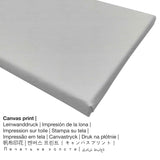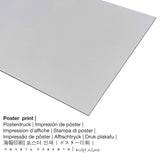Jules Breton, 1868 - The Weeders - fine art print
Tax included. Shipping calculated at checkout.
Background information on the artwork from named Jules Breton
The masterpiece The Weeders was created by the French painter Jules Breton in 1868. The original version had the size: 28 1/8 x 50 1/4 in (71,4 x 127,6 cm). Oil on canvas was used by the painter as the medium of the artwork. Besides, this work of art is in the the The Metropolitan Museum of Art's digital art collection in New York City, New York, United States of America. With courtesy of The Metropolitan Museum of Art, New York, Bequest of Collis P. Huntington, 1900 (public domain). Creditline of the artwork: Bequest of Collis P. Huntington, 1900. Moreover, alignment of the digital reproduction is landscape with a side ratio of 16 : 9, which implies that the length is 78% longer than the width. The writer, poet, painter Jules Breton was a European artist from France, whose artistic style can primarily be classified as Realism. The European artist was born in the year 1827 and passed away at the age of 79 in the year 1906.
Pick your material
In the dropdown lists right next to the product you can select your prefered size and material. Choose among the following product options now to match your preferences in size and material:
- The poster print (canvas material): The poster is a printed canvas with a nice surface texture. Please keep in mind, that depending on the size of the poster print we add a white margin of around 2-6 cm round about the work of art, which facilitates the framing with your custom frame.
- The glossy acrylic glass print (with real glass coating): The acrylic glass print, which is often referenced as a an art print on plexiglass, changes your favorite original work of art into amazing home décor and forms a good alternative to canvas and dibond prints. The artwork is being made with state-of-the-art UV direct print machines. The image effect of this are deep, intense colors. Our acrylic glass protects your custom art print against light and heat for many more years to come.
- Canvas: The printed canvas stretched on a wood stretcher frame. Additionally, a printed canvas makes a lovely, pleasant effect. Canvas prints are relatively low in weight, which means that it is easy and straightforward to hang the Canvas print without additional wall-mounts. A canvas print is suited for all kinds of walls.
- Aluminium dibond print: Aluminium Dibond prints are prints on metal with a true effect of depth. The bright & white sections of the original work of art shimmer with a silky gloss but without any glow. The colors of the print are luminous in the highest definition, the details are crisp and clear, and you can feel the matte appearance of the surface. This UV print on aluminium is one of the most popular entry-level products and is an extremely stylish way to showcase art prints, as it draws attention on the whole artwork.
Legal disclaimer: We do everything in order to depict our art products with as many details as possible and to exhibit them visually in our shop. Please keep in mind that the pigments of the printed materials, as well as the imprint can diverge marginally from the image on the screen. Depending on the settings of your screen and the condition of the surface, not all colors are printed as realistically as the digital version depicted here. In view of the fact that all fine art prints are processed and printed manually, there might as well be slight discrepancies in the size and exact position of the motif.
The product
| Product type: | art reproduction |
| Reproduction: | digital reproduction |
| Production process: | digital printing (UV direct print) |
| Manufacturing: | manufactured in Germany |
| Type of stock: | production on demand |
| Intended usage: | art reproduction gallery, art collection (reproductions) |
| Alignment: | landscape format |
| Image ratio: | length : width - 16 : 9 |
| Meaning of the image ratio: | the length is 78% longer than the width |
| Item material choices: | canvas print, acrylic glass print (with real glass coating), poster print (canvas paper), metal print (aluminium dibond) |
| Canvas on stretcher frame (canvas print) sizes: | 90x50cm - 35x20", 180x100cm - 71x39" |
| Acrylic glass print (with real glass coating) options: | 90x50cm - 35x20", 180x100cm - 71x39" |
| Poster print (canvas paper) variants: | 90x50cm - 35x20" |
| Aluminium dibond print options: | 90x50cm - 35x20" |
| Art print framing: | not available |
Background information about the original work of art
| Name of the artwork: | "The Weeders" |
| Categorization of the artwork: | painting |
| Category: | modern art |
| Temporal classification: | 19th century |
| Created in: | 1868 |
| Age of artwork: | more than 150 years |
| Original medium of artwork: | oil on canvas |
| Size of the original artwork: | 28 1/8 x 50 1/4 in (71,4 x 127,6 cm) |
| Museum / collection: | The Metropolitan Museum of Art |
| Location of museum: | New York City, New York, United States of America |
| Museum website: | The Metropolitan Museum of Art |
| Artwork license type: | public domain |
| Courtesy of: | The Metropolitan Museum of Art, New York, Bequest of Collis P. Huntington, 1900 |
| Creditline of artwork: | Bequest of Collis P. Huntington, 1900 |
About the painter
| Artist: | Jules Breton |
| Also known as: | Breton Jules Adolphe, breton j., j breton, Breton Jules Adolphe Aimé Louis, Breton Jules-Adolphe-Aimé-Louis, Jules Adolphe Aimé Louis Breton, Breton J., Breton Jules-Adolphe-Aime Louis, Breton, Breton Adolph Aime Louis, Jules Breton, J. Breton, Adolph Aime Louis, Jules-Adolphe-Aimé-Louis Breton, breton jules, Juels Breton, ברטון ז'ול, Breton Jules |
| Gender: | male |
| Nationality of artist: | French |
| Professions: | painter, poet, writer |
| Home country: | France |
| Classification of the artist: | modern artist |
| Styles of the artist: | Realism |
| Died at the age of: | 79 years |
| Year of birth: | 1827 |
| Died in the year: | 1906 |
© Copyright protected | Artprinta.com (Artprinta)
Original information about the work of art from the museum's website (© Copyright - by The Metropolitan Museum of Art - The Metropolitan Museum of Art)
This is a smaller variant of a composition Breton painted in 1860 (Joslyn Art Museum, Omaha) and exhibited to wide acclaim at the Salon of 1861 and the World’s Fair of 1867 in Paris. In his autobiography, Breton described this twilight scene of peasants pulling up thistles and weeds—"their faces haloed by the pink transparency of their violet hoods, as if to venerate a fecundating star"—noting that he had discovered the subject as a "finished picture" near his native village, Courrières, in northern France.














